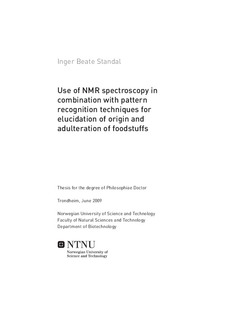| dc.contributor.author | Standal, Inger Beate | nb_NO |
| dc.date.accessioned | 2014-12-19T13:14:14Z | |
| dc.date.available | 2014-12-19T13:14:14Z | |
| dc.date.created | 2009-08-24 | nb_NO |
| dc.date.issued | 2009 | nb_NO |
| dc.identifier | 232500 | nb_NO |
| dc.identifier.isbn | 978-82-471-1611-1 (printed ver.) | nb_NO |
| dc.identifier.isbn | 978-82-471-1613-5 (electronic ver.) | nb_NO |
| dc.identifier.uri | http://hdl.handle.net/11250/245610 | |
| dc.description.abstract | Consumers and food authorities are, to an increasing extent, concerned about factors such as the origin of food, how it is produced, and if it is healthy and safe. There are methods for general quality control to map the safety and nutritional value; however there is a need for suitable analytical methods to verify information such as the production method (wild/farmed), geographical origin, species, and process history of foods.
This thesis evaluates the applicability of using nuclear magnetic resonance (NMR) spectroscopy combined with pattern recognition techniques for authentication of foodstuffs. Fish and marine oils were chosen as materials. 13C NMR was applied to authenticate marine oils and muscle lipids of both fatty and lean fish, according to production method (wild/farmed), geographical origin, species, and process history. 1H NMR was applied on low molecular weight compounds extracted from cod muscle to authenticate fish according to species and processing conditions.
13C NMR combined with pattern recognition techniques enabled the differentiation of marine oils according to wild/farmed and geographical origin of the raw material. It is suggested that this was mainly due to the different diets of the fish from which the oil was produced. It was also possible to authenticate marine oils according to species, and to say something about the level of mixtures detectable. The sn-2 position specificity of fatty acids in triacylglycerols was shown to be an important characteristic to separate oils of different species. Esterified fish oil (concentrates) could easily be differentiated from natural fish oil by their 13C NMR profile.
13C NMR on muscle lipids, combined with pattern recognition techniques enabled the classification of wild and farmed salmon. The classification according to geographical origin was somewhat more complicated. A combination of analytical methods may be the best approach to obtain reliable results on geographical origin of fish. The analysis of lean fish showed that it was possible to classify lean gadoids according to species, and two stocks of Atlantic cod could be differentiated. There were also minor differences in the sn-2 position specificity of 22:6n-3 in phosphatidylcholine (PC) and phosphatidylethanolamine (PE) among the species investigated.
1H NMR on water soluble extracts of fish muscle provided information about a wide range of compounds, and the two species investigated (cod and haddock) displayed different 1HNMR profiles. Dimethylamine (DMA) was used as a marker for frozen, non processed fish. When applying the 1H NMR data in pattern recognition techniques, frozen fish could be differentiated from non-frozen fish, and in the classification of the cod of the different processing methods 80% of the samples were correctly classified.
Common for the methods presented in this thesis, NMR spectroscopy combined with pattern recognition for authentication of traceability data on foodstuffs, is the need for databases with analytical data on reference samples, covering the natural variation among the samples to be classified. Databases for marine oils need not be as extensive as for fish, since marine oils are generally produced from fish batches. Oils can also be analyzed directly without extensive sample preparation, and the greatest potential for official application may lie in the analysis of oils.
| nb_NO |
| dc.language | eng | nb_NO |
| dc.publisher | Norges teknisk-naturvitenskapelige universitet, Fakultet for naturvitenskap og teknologi, Institutt for bioteknologi | nb_NO |
| dc.relation.ispartofseries | Doktoravhandlinger ved NTNU, 1503-8181; 2009:114 | nb_NO |
| dc.title | Use of NMR spectroscopy in combination with pattern recognition techniques for elucidation of origin and adulteration of foodstuffs | nb_NO |
| dc.type | Doctoral thesis | nb_NO |
| dc.contributor.department | Norges teknisk-naturvitenskapelige universitet, Fakultet for naturvitenskap og teknologi, Institutt for bioteknologi | nb_NO |
| dc.description.degree | PhD i bioteknologi | nb_NO |
| dc.description.degree | PhD in Biotechnology | en_GB |

